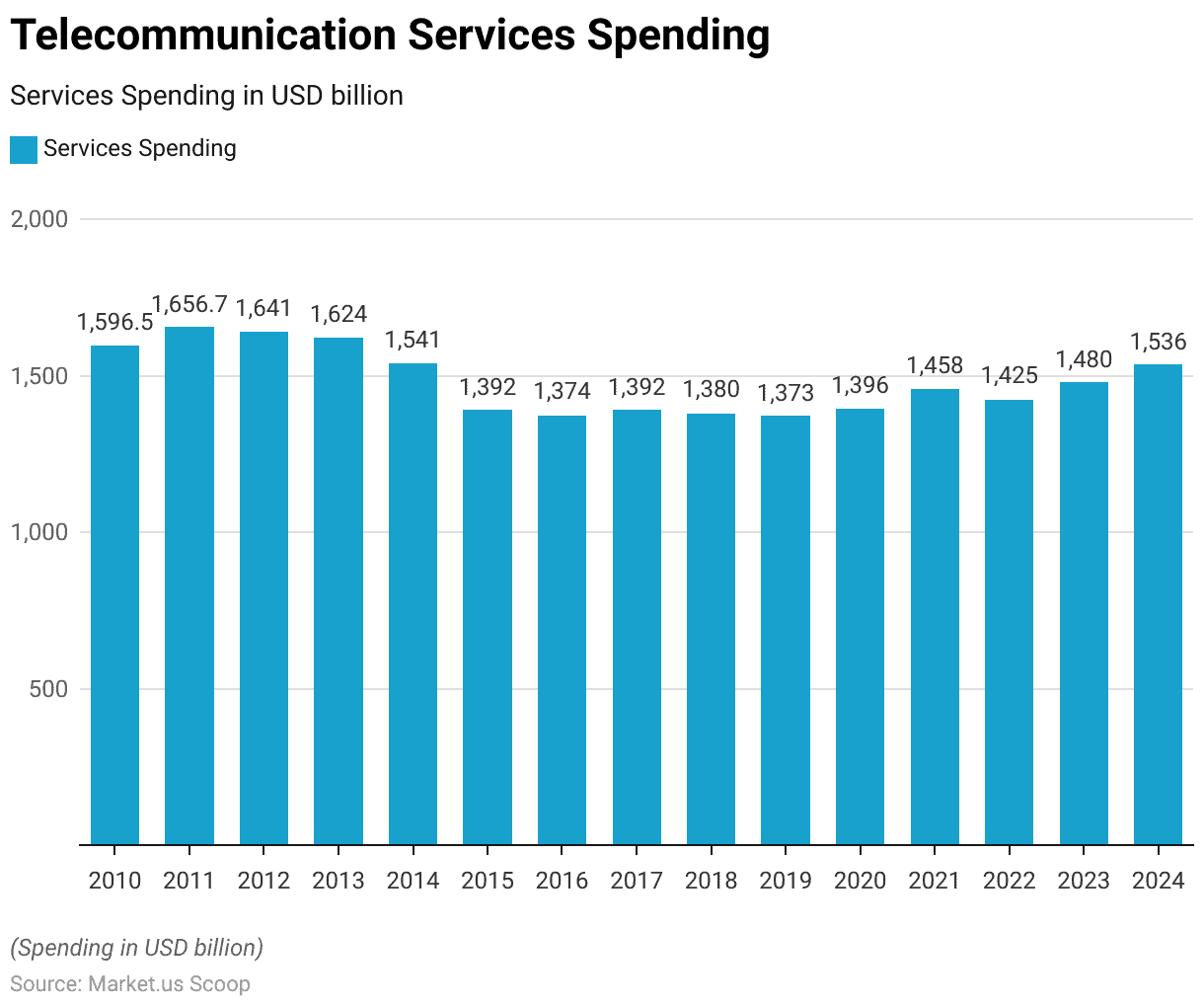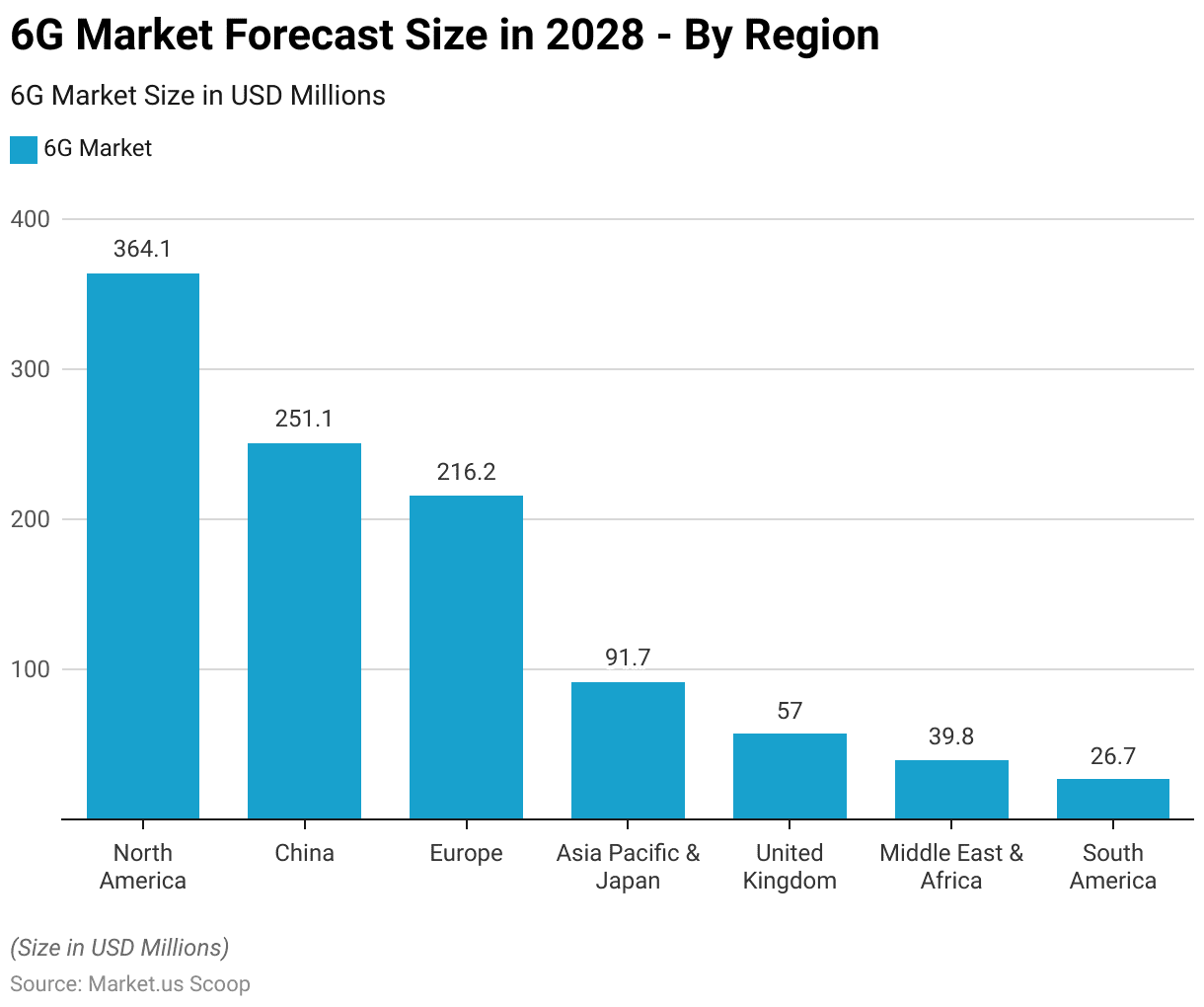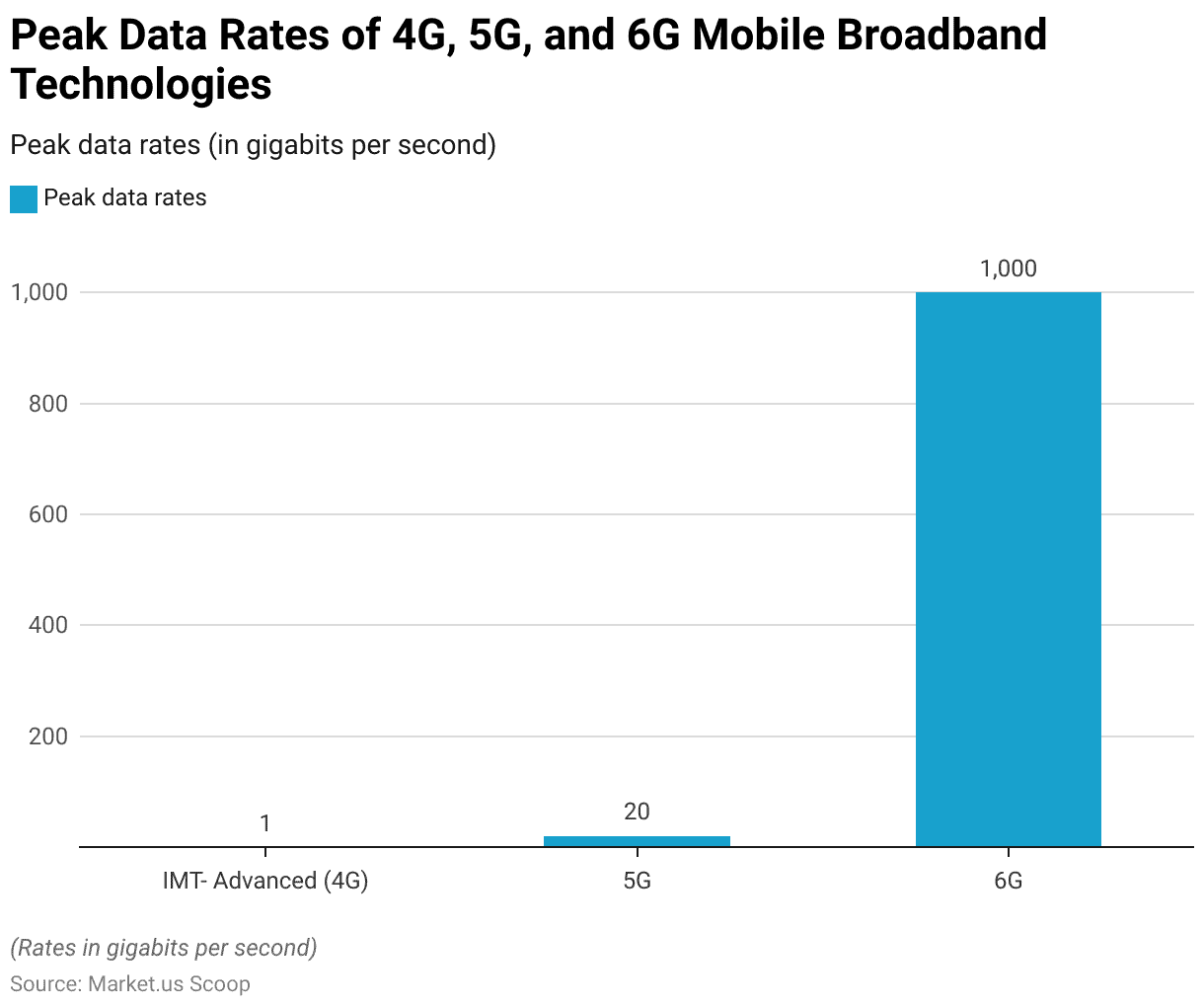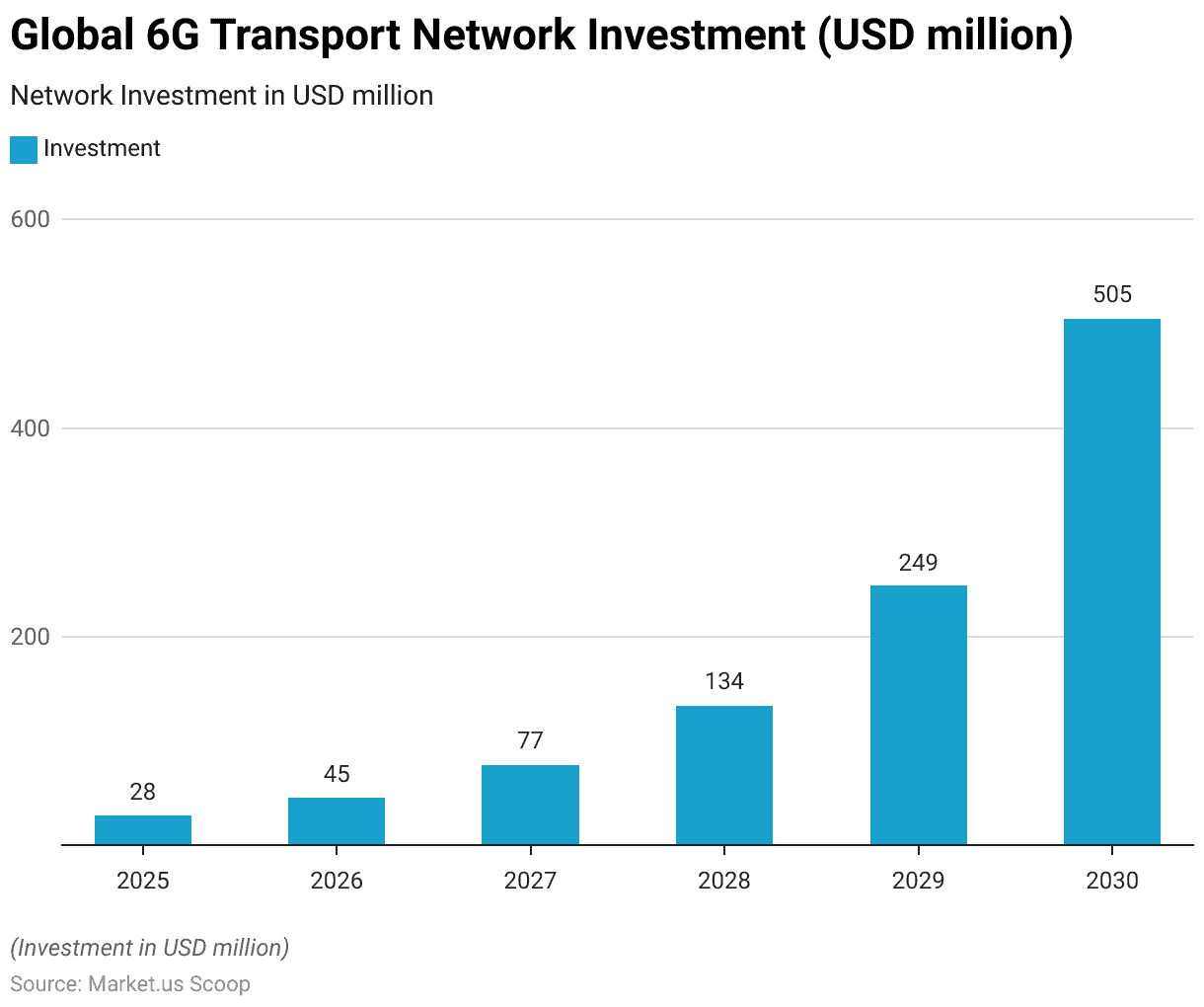Table of Contents
Introduction
According to 6G Statistics, 6G technology, marking the sixth generation of wireless communication, is on the horizon, poised to outshine 5G networks. Its goal is to provide faster internet speeds, almost instantaneous connections, and improved device connectivity.
What makes it particularly thrilling is its potential to support cutting-edge technologies such as augmented reality, virtual reality, and the Internet of Things. The development of 6G involves collaboration among industry leaders and research institutions, with a focus on innovations like terahertz communication and intelligent networking. As it continues to progress, 6G can transform various industries and reshape how we engage with the digital realm.
Editor’s Choice
- In the projected landscape of 6G technology, the market size in 2028, North America is anticipated to lead the way with a substantial 6G market size of approximately 364.12 million U.S. dollars.
- The spectrum allocation for 6G includes the upper mid-band, often called mid-band or unofficially referred to as FR3, spanning from 7 to 24 GHz.
- The range between 7 and 15 GHz is appealing due to its propagation characteristics, which resemble those of frequencies just below 7 GHz.
- The bandwidths of up to 20 GHz are explored for 6G applications, despite the significant technical challenges they pose.
- The data rate for 6G is projected to reach a remarkable 1 terabit per second (TBPS), a monumental leap from the 100-1000 Mbps of 5G, indicating an unparalleled increase in data transmission speeds.
- Looking ahead to the anticipated 6G technology, it is projected to achieve an astounding peak data rate of 1000 Gbps (1 terabit per second or TBPS), an exponential leap that promises to revolutionize the mobile broadband landscape.
- By 2030, the 6G transport network investment is projected to reach 505 million U.S. dollars.
Global Telecommunications Industry Statistics
- Over the past decade, spending in the telecommunications services industry has exhibited fluctuations and trends.
- In 2010, it stood at $1,596.5 billion, and it continued to rise in the subsequent years, reaching $1,656.7 billion in 2011.
- In 2021, there was a notable rise to $1,458.0 billion, and projections indicate that spending will reach $1,425.0 billion in 2022, followed by an increase to $1,480.0 billion in 2023 and $1,536.0 billion in 2024.
- Furthermore, by 2024, the total revenue potential for mobile operators from Value-Added Services (VAS) is predicted to hit $120 billion, with Application-to-Person (A2P) Messaging and Machine to Machine (M2M) Connectivity emerging as the primary drivers of this growth.

Global 6G Market Statistics
Regional Analysis of the 6G Market
- North America is anticipated to lead the way with a substantial 6G market size of approximately 364.12 million U.S. dollars, followed closely by China with an estimated market size of 251.14 million U.S. dollars.
- Europe is also poised to play a significant role, with a projected 6G market size of around 216.21 million U.S. dollars.
- In the Asia Pacific & Japan region, the market is expected to reach 91.66 million U.S. dollars.
- The United Kingdom is foreseen to contribute approximately 57.01 million U.S. dollars to the 6G market, while the Middle East & Africa region is expected to have a market size of about 39.83 million U.S. dollars.
- Finally, South America is projected to have a market size of roughly 26.69 million U.S. dollars.

6G Spectrum Landscape Statistics
- The spectrum allocation for 6G is currently uncertain, but there are ongoing discussions about three potential frequency ranges.
- These include the upper mid-band, often called mid-band or unofficially referred to as FR3, spanning from 7 to 24 GHz.
- Additionally, there are discussions about sub-terahertz bands, covering approximately 90 GHz to 300 GHz.
- Finally, efforts are being made to maximize the available spectrum below 7 GHz through methods such as re-farming, allocating new bands, and enhancing spectral efficiency.
The upper mid-band (7–24 GHz)
- The range between 7 and 15 GHz is appealing due to its propagation characteristics, which resemble those of frequencies just below 7 GHz.
- Signals in this range experience lower propagation loss compared to the FR2 spectrum, making them better at penetrating buildings and structures, thereby enhancing indoor coverage.
- This presents an opportunity for network operators to boost capacity without the necessity of deploying a substantial number of cell sites, which is typically required for expanding millimeter-wave (mmWave) FR2 coverage.
The sub-terahertz bands (90–300 GHz)
- Sub-terahertz frequencies, offering substantial, uninterrupted spectrum portions, are a valuable consideration for 6G.
- With bandwidths of up to 20 GHz, they should be explored for 6G applications, despite the significant technical challenges they pose.
- There is a foreseeable need for applications demanding extremely high data speeds, exceeding 100 Gbps.
- The specific frequencies within the sub-terahertz range, such as the 90-110 GHz (W band) and the 110-170 GHz (D band), are still under consideration for mobile or fixed wireless use.
The lower bands (below 7 GHz)
- The frequency bands from 600 MHz to 900 MHz will remain crucial for wide area coverage due to their extensive reach and effective penetration of both outdoor and indoor environments.
- In the next five to ten years, a new spectrum between 1 GHz and 7 GHz will be acquired for both mobile and fixed wireless communication to meet the high throughput demands of 5G, which will also benefit 6G.
- Several new bands are under consideration for allocation, including 3.3–3.4 GHz, 3.6–3.8 GHz, 6.425–7.025 GHz, and 7.025–7.125 GHz, with the last one identified for global usage.
- Re-evaluating how this spectrum is utilized and repurposing it, as seen in the C band for 5G, is an example of obtaining wider bandwidths below 7 GHz.
Comparison of 6G with The Previous Mobile Communication Technologies
- A detailed comparison of 6G with its predecessors reveals significant advancements in mobile communication technologies.
- The data rate for 6G is projected to reach a remarkable 1 terabit per second (TBPS), a monumental leap from the 100-1000 Mbps of 5G, indicating an unparalleled increase in data transmission speeds.
- End-to-end latency is expected to be reduced to an impressive 1 millisecond (ms) in 6G, compared to the 10 ms of 5G, promising almost real-time communication.
- 6G boasts the highest spectral efficiency at 100 bps/Hz, an exponential improvement over the 30 bps/Hz of 5G, signifying an efficient use of spectrum resources.
- Furthermore, 6G demonstrates remarkable network mobility support, allowing speeds of up to 1000 km/hr, compared to the 500 km/hr of 5G.
Peak Data Rates
- Mobile broadband technologies have witnessed remarkable advancements in peak data rates over the years.
- The previous generation, IMT-Advanced or 4G, offered peak data rates of 1 gigabit per second (Gbps), which marked a significant leap from its predecessors.
- With the advent of 5G, peak data rates soared to 20 Gbps, showcasing a substantial improvement in data transmission speeds.
- Looking ahead to the anticipated 6G technology, it is projected to achieve an astounding peak data rate of 1000 Gbps (1 terabit per second or TBPS), an exponential leap that promises to revolutionize the mobile broadband landscape.

User Experience Data Rates
- In the realm of mobile broadband technologies, user experience data rates have witnessed remarkable evolution.
- The previous generation, IMT-Advanced or 4G, provided user experience data rates of 10 megabits per second (Mbps), representing a notable improvement over its predecessors.
- With the introduction of 5G, user experience data rates escalated to 100 Mbps, signifying a significant enhancement in mobile broadband performance.
- Looking ahead to the anticipated 6G technology, it is projected to deliver extraordinary user experience data rates of 1000 Mbps (1 gigabit per second or Gbps), marking an exponential leap that promises to redefine the way users interact with digital content and services.

6G Network Use Cases
- In the ongoing discussions about 6G, a central theme revolves around the advancement of machine-to-machine (M2M) communications.
- One notable aspect is the freedom from constraints imposed by data rates, allowing millions of devices in a relatively small area to collaborate on intricate tasks requiring substantial computational power without overwhelming the network.
- This paves the way for networks where multiple devices, equipped with artificial intelligence and machine learning capabilities, can collaborate seamlessly on complex assignments.
- Additionally, organizations like Samsung, Nokia, and the International Telecommunications Union (ITU) have outlined other potential use cases in recent whitepapers.
- These include truly immersive experiences through XR high-fidelity (a blend of virtual reality, augmented reality, and mixed reality), high-quality holograms, and digital replicas.
6G Transport Network Investment Projections
- The global investment in 6G transport networks is projected to experience substantial growth in the coming years.
- In 2025, the investment is estimated at 28 million U.S. dollars, signaling the initial steps in the development of this advanced network.
- Looking ahead to 2029, the investment is set to nearly double, reaching 249 million U.S. dollars, and by 2030, it is projected to reach a substantial 505 million U.S. dollars.

Privacy Challenges in 6G Technology
- Privacy is a significant concern in 6G innovation, given the potential for global connectivity to expose an individual’s entire life through a single data breach.
- New York State has enacted regulations, such as the SHIELD Act, requiring “reasonable” security measures, including training and adapting protocols. The Act empowers fines for non-compliance.
- The California Consumer Privacy Act, implemented in 2018, imposes fines of $750 per breach per consumer per occurrence or actual damages.


